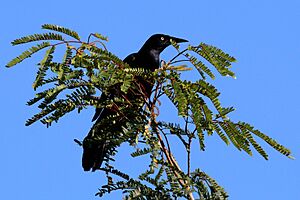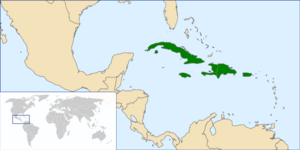Greater Antillean grackle facts for kids
Quick facts for kids Greater Antillean grackle |
|
|---|---|
 |
|
| Q. n. gundlachii in Cayo Coco, Cuba | |
| Conservation status | |
| Scientific classification | |
| Genus: |
Quiscalus
|
| Species: |
niger
|
 |
|
| Range of Q. niger | |
The Greater Antillean grackle (Quiscalus niger) is a type of grackle bird. You can find it all over the Greater Antilles islands and some smaller islands nearby. Like other grackles in the Quiscalus family, it's a fairly large bird that likes to live in groups. These birds often live in places where many people live.
Contents
Cool Names for the Grackle
This grackle has different fun names depending on where you are! In Jamaica, people call it the 'kling-kling'. In the Dominican Republic, it's known as 'chinchilín'. If you're in the Cayman Islands, you might hear it called 'ching ching'. And in Puerto Rico, it's known as a 'chango'. Most of these local names sound a lot like the calls the bird makes!
How Scientists Name and Classify Birds
Scientists use a special system called taxonomy to name and group all living things. This helps them understand how different animals are related.
Early Discoveries
A long time ago, in the late 1600s, an Irish doctor and naturalist named Hans Sloane visited Jamaica. He collected many plants and animals, including this grackle. Based on his notes, another scientist, John Ray, wrote a short description of the bird in 1713.
Later, in 1775, a French scientist named Georges-Louis Leclerc, Comte de Buffon also described the Greater Antillean grackle. An artist even drew a picture of it! In 1783, a Dutch naturalist named Pieter Boddaert gave the bird its first scientific name, Oriolus niger. The word niger is Latin for "black."
The Grackle's Scientific Family
Today, the Greater Antillean grackle is part of a group of birds called the Quiscalus genus. This group was named by a French scientist, Louis Pierre Vieillot, in 1816. There are seven types of Quiscalus grackles, though one is now extinct.
Different Types on Different Islands
There are seven different kinds, or subspecies, of the Greater Antillean grackle. Each one lives on a specific island or group of islands. They might look a little different from each other in size or color.
- Q. n. niger: Found on Hispaniola (which includes Haiti and the Dominican Republic).
- Q. n. caribaeus: Lives in western Cuba and on Isla de Juventud.
- Q. n. gundlachii: Found in central and eastern Cuba.
- Q. n. caymanensis: Lives on Grand Cayman Island.
- Q. n. bangsi: Found on Little Cayman Island.
- Q. n. crassirostris: Lives in Jamaica.
- Q. n. brachypterus: Found in Puerto Rico.
What the Grackle Looks Like and Eats
The male Greater Antillean grackle is about 27 cm (11 in) long. It's a shiny black color and has a large tail that looks a bit like a boat's rudder. The female is a bit smaller, about 24 cm (9.4 in) long, and her tail is smaller too. She is also black, but not as shiny as the male. The only part of the bird that isn't black is its bright yellow eye!
These grackles are not picky eaters. They eat many different things, like fruits, bread, and other plant parts. They also enjoy eating small animals without backbones (like insects) and even small animals with backbones.
Gallery
See also








